I’ve always kept my distance from bees, I’ll blame it on a horror movie that I stupidly watched by myself when I was home sick from school. I’ve never been stung before, nor do I really care to purposely put myself in a situation where I might be.
But uh…..colony collapse? I’m more freaked out about that then a little sting. While I’ll leave the full scale beekeeping to my heroes, naked beekeeping to this brave one, and fighting against honey laundering to these guys — I thought perhaps we could provide a place to nest for Orchard Mason Bees. We hung this guy up 2 days ago.
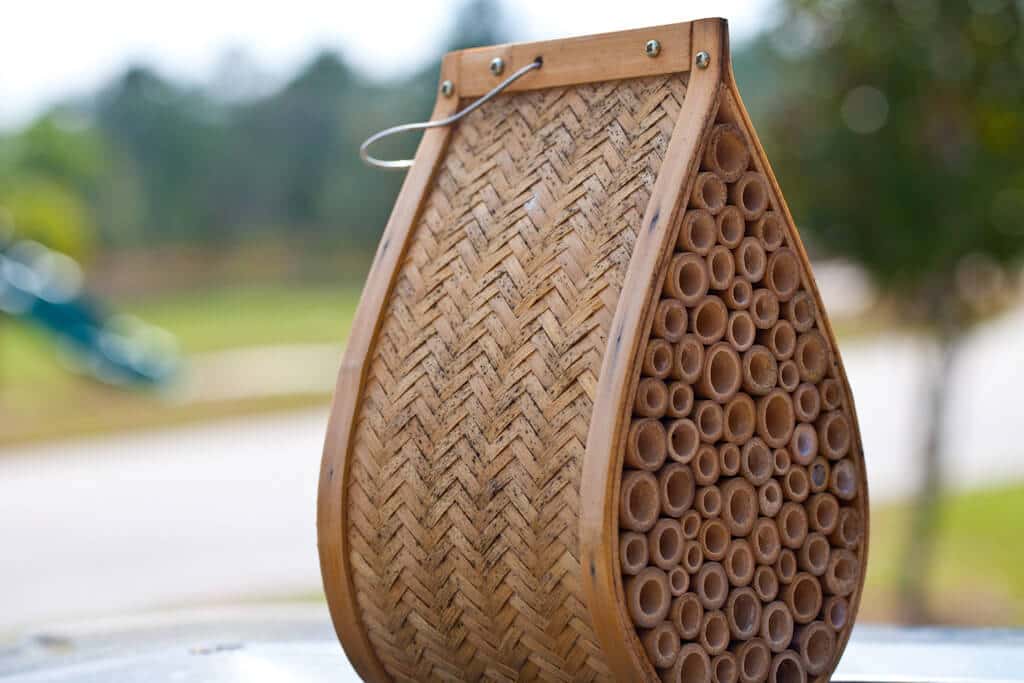
 What are Orchard Mason Bees?
What are Orchard Mason Bees?
(photo from Naturewide Images) Mason bees don’t produce honey, but do play an important role in pollinating, especially fruit trees – according to Gardener’s Supply, each bee visits as many as 1000 blooms per day — 20 times as many as a honeybee. Best part about mason bees? THEY ARE LESS LIKELY TO STING!!!!
In North America, they are blue-green (pretty!) and are smaller than honeybees — they kinda look like house flies.
The mason bee lay their eggs in small hollow spaces, like reeds, cracks in wood and even snail shells. The mason bees are gentle, hard working but don’t get the attention or glory that honey bees get (poor guys!)

I bought this cute bamboo mason bee home from Gardener’s Supply for $16.95. If you’re handy, you could make your own by drilling holes in a chunk of non-treated wood, or even buying these bamboo reeds specifically designed for mason bees and designing your own château for these buzzing creatures.
We placed our bamboo mason bee house in the garden area – it hangs from the roof of the chicken coop – within 2 days we saw bee activity.
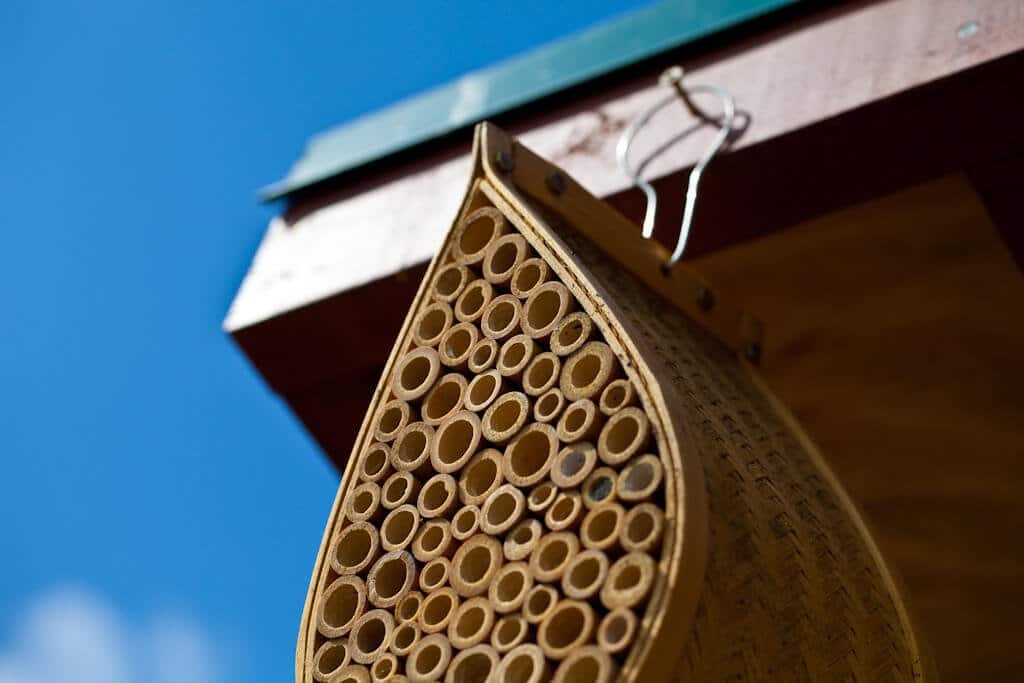
The mason bee places a mud plug near the edge of the hole and then goes back and forth between flower and house to collect nectar and pollen for food for her larva. Once she’s done, the hole is completely plugged with more mud.
(why am I writing in the voice of the honey badger guy?)
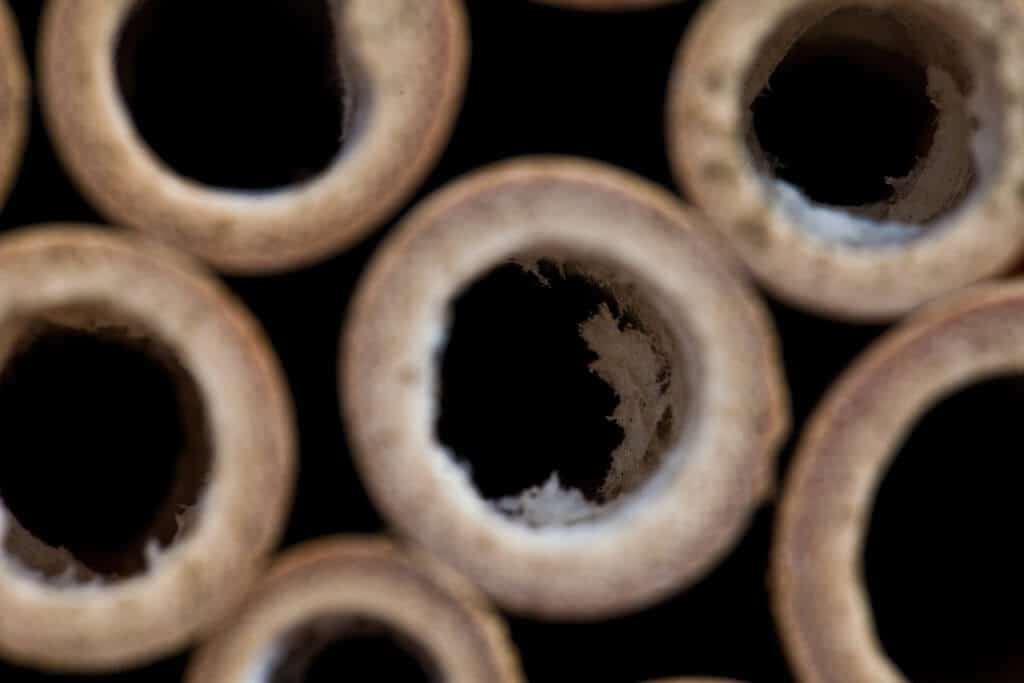
The female lays her eggs – mama knows which eggs will be male and which will be female – the males are laid near the entrance and the females are near the back. Why? Because the females are more important and the males are more expendable (I swear I’m not making this up) so they’re near the front in case a predator comes by and breaks through the plug or if bad weather comes around, the females are more protected in the back.
Within a few days, the larva will hatch and eat up the pollen buffet before they spin a cocoon to hang out until the Spring.
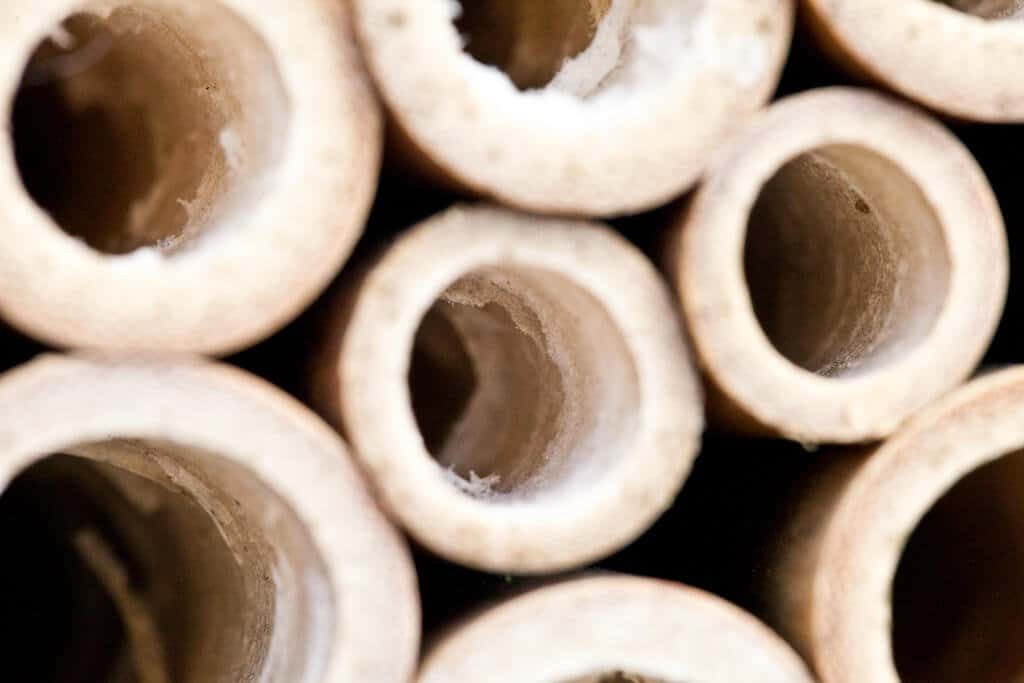
Male bees hatch first and they chew their way out of the mud plug. Females follow a few days later.
Pretty darn cool, huh?
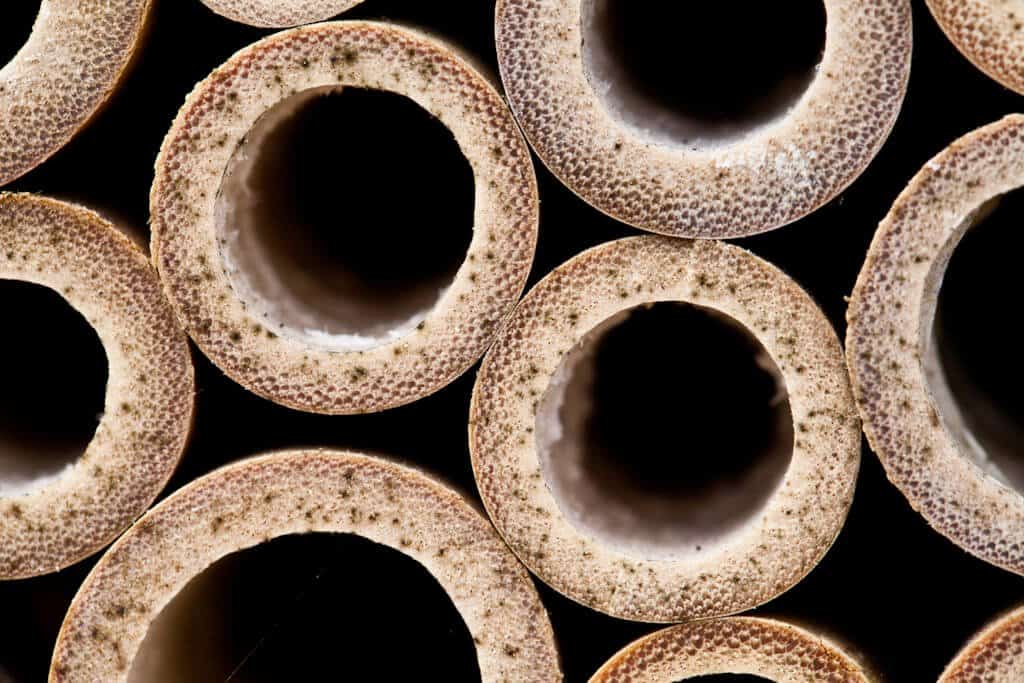
I was hoping to catch a bee inside (we saw a few yesterday working on this plug)

I’m hoping within a couple of weeks, we’ll have full occupancy.

There’s plenty of room, awesome view and rent is cheap (just don’t sting me) in the good part of town.
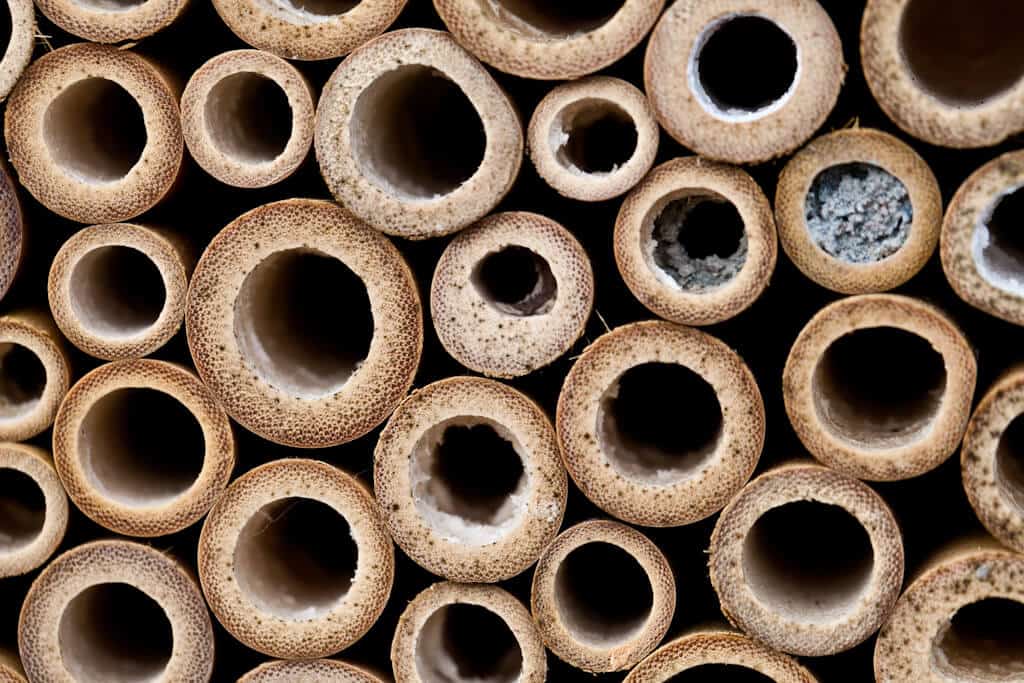
Even if you don’t have a yard, I hope you consider hanging one of these up outside – bee keeping can be as easy as this!
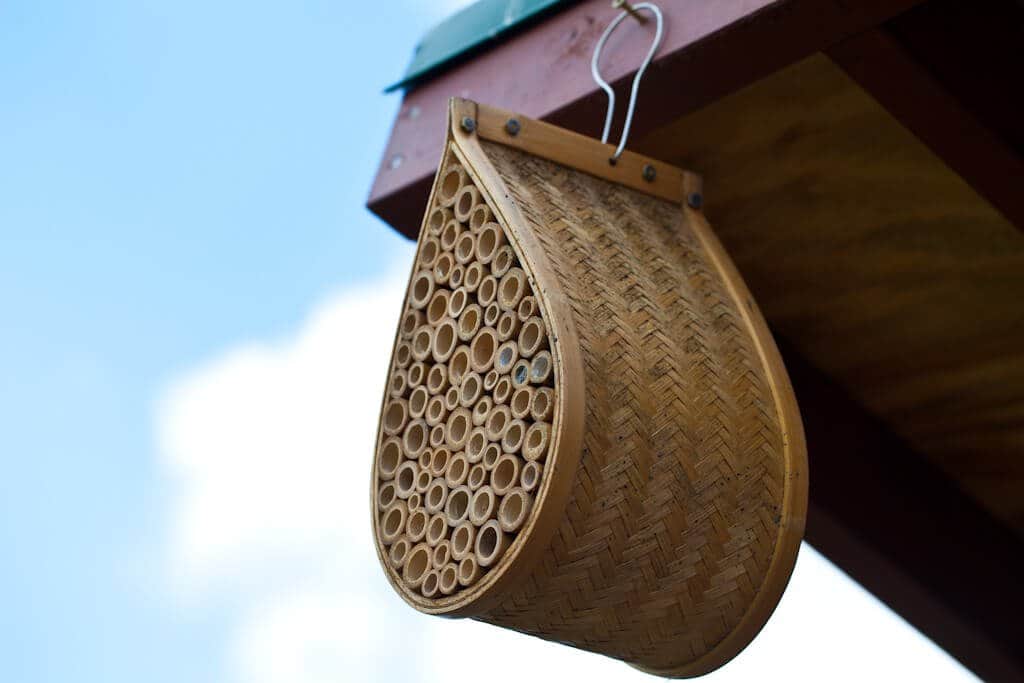
Learn more about Orchard Mason Bees
Mason Bee info – Buzz About Bees
Mason Bees – GardenGuy06 (YouTube)
Where to put a Mason Bee house – Crown Bees
Bamboo Mason Bee House – Gardener’s Supply
You can even buy Mason Bees
Mason Bee homes for sale (Canada)
Watch a Mason Bee emerge – YouTube

 What are Orchard Mason Bees?
What are Orchard Mason Bees?



Sorry to contradict you Dave, but we do have Mason bees in Florida. I was putting up a new Mason bee house and before I could get it hung and get back on the ground, I had three Mason bees checking it out. Hopefully they will return to lay there eggs.
Every weekend i used to visit this web site, because i
want enjoyment, for the reason that this this site conations genuinely good funny material too.
Someone just gave me a mason bee house just like yours. When do you put it out? It is October now we are cleaning our garden out and preparing it for winter. I see that you had it out in February, so the first of the year? Or is right now okay? Thanks!!! Love your post!!
That’s not mold. It’s the mud the bees use to secure the entrance to their nesting tunnels.
There aren’t “killer bees.” The sooner you accept that cheap media and movie sensationalism the sooner you can accept that most of the food you eat is assisted by bees.
In Florida, Texas and the Southern part of the United States you have a higher population of Africanized Bees. These bees are more defensive and are more productive in the hot and humid climates, unlike the European families of Honey Bee that populate California through the Midwest into the the North East region of America.
Africanized Bees are more defensive, but many countries, have their honey crops from these bees.
Honey bees do not sting unless being trapped or threatened while away from the hive…
So if you’re getting stung by bees you’re either… #1 messing around with their hive in some way #2 have one trapped in a piece of clothing or your hair #3 harassing the bee my attempting to grab, trap or harm her.
Bees die through disembowelment when they sting you. Their venom sac and entrails are attached to the stinger as it remains in your body and they fly off. So for a bee to actually give up their life they have to feel like they (or their hive) are in mortal danger.
is it true that it only takes one killer bee to convert a nest? That makes me uneasy since we have killer bees here in FL.
Oh my gosh, now that I see them up close, I’m positive that I’ve seen them in the summer… I always thought they were just large, loud houseflies!
When I first saw the picture of your Mason Bee House, I assumed it was made of wine corks. I’m looking into buying one myself, that is extremely cheap. Thanks for sharing this! (…and I loved the honey badger reference, ha!)
wow! it’s a very interesting read, but at the same time, i feel an anaphylaxis coming on. i’m sorry, but that’s something i don’t think i will be able to get into due to severe allergies.
good luck! i hope you get a lot of tenants soon.
How cool, Jaden!
Amazing post, Jaden. Plus, I appreciate the other links you added – don’t know where you find some of these! The bee house looks lovely – hope you get many new bees from it.
I love your photos. You are so adventures with chickens and now bees.
Vyki,
In general, the mason bees are native to most of the US. You’ll find them absent in the too-warm SE (Missouri/FL).
Crew, bamboo does get moldy and it’s not easy to harvest from. (it can’t be opened) What’s best is native reeds, kraft paper tubes, or wood trays. Search for mason bee harvesting to see what’s required. (it’s fairly easy!)
Chris, they probably aren’t in your herbs unless they are blossoming in the early spring. Mason bees are a March-early June pollinator!
Diana, In discussion with ARS/Logan Bee Lab, you can’t get anaphelatic shock from mason bees. the venom is too mild. AND, you have to get stung. It’s VERY hard to get stung from these gentle bees.
Jaden is a mason bee slumlord, pass it on:)
(So you don’t keep them in a mason jar? My bad.)
Bee all that you can bee.
Seriously interesting post. I’ve seen these in our herbs but didn’t know what they were.
it looks like it’s getting moldy. how do you treat that?
I am very intrigued by the bees. My question is how do you attract those kind of bees. I don’t know if they are in my area.
Only thing is you have to place the house out of the way of the elements. If it rains in the holes the plugs will wash away and the hive will be ruined.
Very cool! I, too, fret about colony collapse. We need our bees!
Your chicken palace looks amazing! Do your pampered poultry get pedicures? I hope they appreciate their classy digs.
after giving poultry pedicures, I’d probably need stitches 🙂
Thank you for this very interesting and informative article!
Nice! I will have to buy this. Thanks for sharing.
I’m allergic to bees but have thought about getting Mason bees for all the various fruit trees and bushes I’ve been putting in. I’ve heard they’re much less likely to sting. That house is such a beautiful design, I may just give it a try!
Mason bee keeper for two years. If a gentle mason bee were caught up in your clothing or sat upon, they might poke you but they have no venom. Their “sting” is no worse than a mosquito bite as their stinger is actually an egg guide.
You have little to fear from these charming little she-bees. They are good company too.
You are brave. I am crazy scared of bees. I don’t know why though. Maybe it is from watching My Girl when I was younger. Either way, I have bee and hornet nests all around my house. They freak me out.
Thank you Jaden, for a great post. I was looking at mason bees in a seeds catalog thinking how great it would be in my garden. But I am also afraid of stings. So, I am still debating…
Very cool, Jaden! But I still want my own honey bees. 😉 xo
Wow – Jaden, what a great post. I’m ordering four. Some day there will be chickens too! 🙂